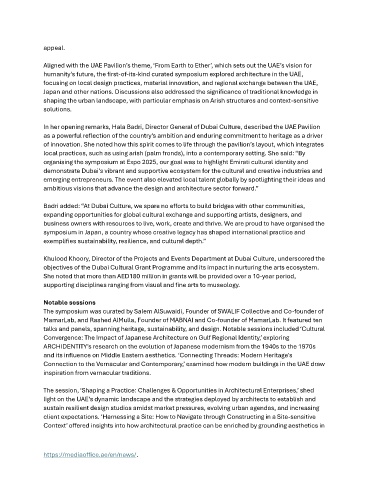Page 327 - MINISTRY OF CULTURE PR REPORT - MAY 2025 (ENGLISH)
P. 327
appeal.
Aligned with the UAE Pavilion’s theme, ‘From Earth to Ether’, which sets out the UAE’s vision for
humanity’s future, the first-of-its-kind curated symposium explored architecture in the UAE,
focusing on local design practices, material innovation, and regional exchange between the UAE,
Japan and other nations. Discussions also addressed the significance of traditional knowledge in
shaping the urban landscape, with particular emphasis on Arish structures and context-sensitive
solutions.
In her opening remarks, Hala Badri, Director General of Dubai Culture, described the UAE Pavilion
as a powerful reflection of the country's ambition and enduring commitment to heritage as a driver
of innovation. She noted how this spirit comes to life through the pavilion’s layout, which integrates
local practices, such as using arish (palm fronds), into a contemporary setting. She said: “By
organising the symposium at Expo 2025, our goal was to highlight Emirati cultural identity and
demonstrate Dubai’s vibrant and supportive ecosystem for the cultural and creative industries and
emerging entrepreneurs. The event also elevated local talent globally by spotlighting their ideas and
ambitious visions that advance the design and architecture sector forward.”
Badri added: “At Dubai Culture, we spare no efforts to build bridges with other communities,
expanding opportunities for global cultural exchange and supporting artists, designers, and
business owners with resources to live, work, create and thrive. We are proud to have organised the
symposium in Japan, a country whose creative legacy has shaped international practice and
exemplifies sustainability, resilience, and cultural depth.”
Khulood Khoory, Director of the Projects and Events Department at Dubai Culture, underscored the
objectives of the Dubai Cultural Grant Programme and its impact in nurturing the arts ecosystem.
She noted that more than AED180 million in grants will be provided over a 10-year period,
supporting disciplines ranging from visual and fine arts to museology.
Notable sessions
The symposium was curated by Salem AlSuwaidi, Founder of SWALIF Collective and Co-founder of
MamarLab, and Rashed AlMulla, Founder of MABNAI and Co-founder of MamarLab. It featured ten
talks and panels, spanning heritage, sustainability, and design. Notable sessions included ‘Cultural
Convergence: The Impact of Japanese Architecture on Gulf Regional Identity,’ exploring
ARCHIDENTITY’s research on the evolution of Japanese modernism from the 1940s to the 1970s
and its influence on Middle Eastern aesthetics. ‘Connecting Threads: Modern Heritage's
Connection to the Vernacular and Contemporary,’ examined how modern buildings in the UAE draw
inspiration from vernacular traditions.
The session, ‘Shaping a Practice: Challenges & Opportunities in Architectural Enterprises,’ shed
light on the UAE’s dynamic landscape and the strategies deployed by architects to establish and
sustain resilient design studios amidst market pressures, evolving urban agendas, and increasing
client expectations. ‘Harnessing a Site: How to Navigate through Constructing in a Site-sensitive
Context’ offered insights into how architectural practice can be enriched by grounding aesthetics in
https://mediaoffice.ae/en/news/.

